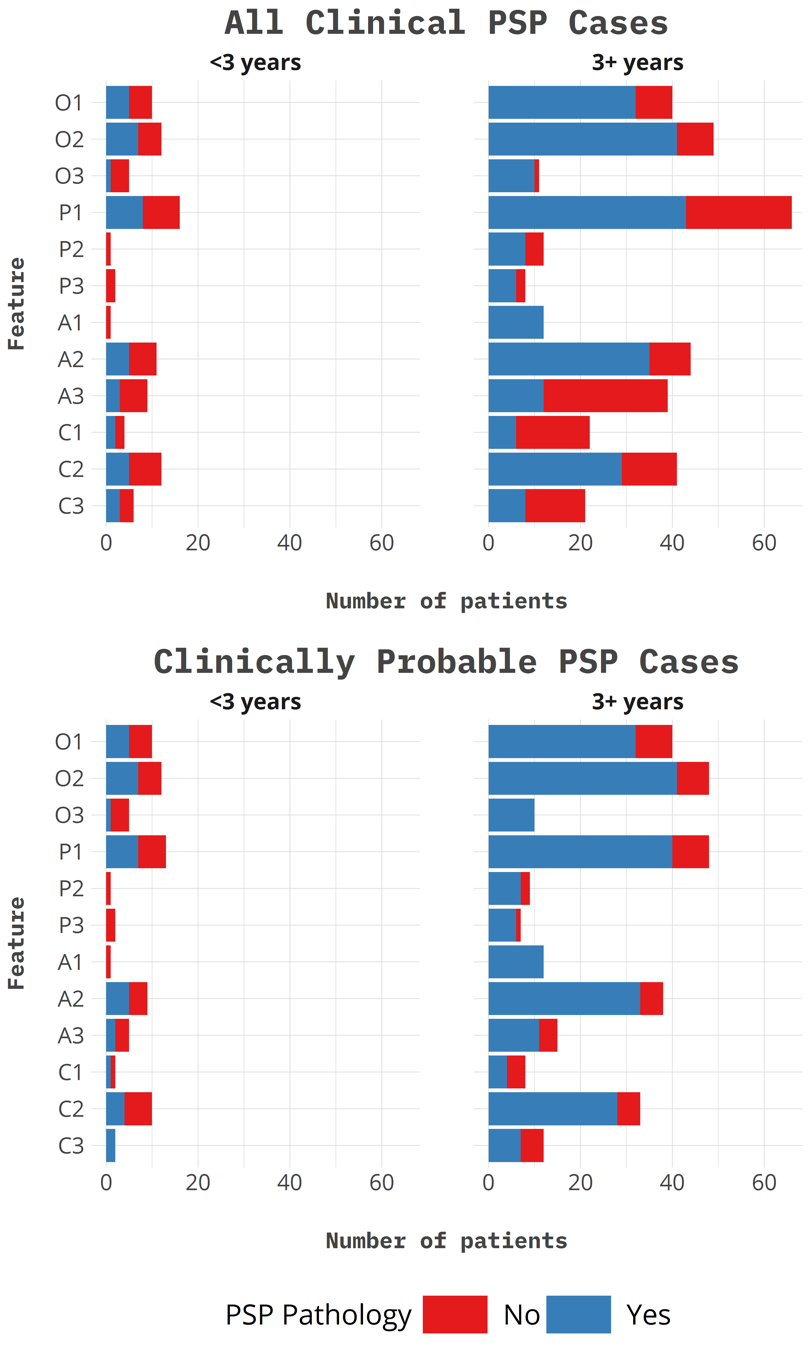Session Information
Date: Tuesday, September 24, 2019
Session Title: Parkinsonisms and Parkinson-Plus
Session Time: 1:45pm-3:15pm
Location: Agora 3 West, Level 3
Objective: Analyze the sensitivity, specificity of the Movement Disorders Society (MDS) criteria for progressive supranuclear palsy (PSP) and apply the multiple allocation extinction (MAX) rules in an autopsy cohort of PSP and other parkinsonian disorders.
Background: The MDS-PSP criteria recognizes various PSP phenotypes. Patients may meet criteria for multiple phenotypes at a single timepoint and phenotypic allocations may evolve throughout the disease course. MAX rules were developed to reduce the degree of multiple diagnostic allocations.1
Method: We retrospectively applied the MDS-PSP criteria to an autopsy confirmed cohort of PSP and other parkinsonian disorders. Each patient was assigned a diagnostic level in the ocular motor, akinesia, postural instability and cognitive dysfunction domains. Combinations of symptoms were then used to calculate all applicable phenotypes per the MDS-PSP criteria. Sensitivity and specificity were calculated, and MAX rules were applied where complete data were available for all clinical domains.
Results: When applied to the whole cohort (66 PSP, 63 non-PSP), the criteria had a sensitivity of 84% and specificity of 81.6% within 3 years of disease onset. Sensitivity approached 100% and specificity 91.4% when applied late in the disease. For the subset with complete data available (54 PSP, 56 non-PSP), application of the MAX rules reduced the number of phenotypes from 378 to 55 in the PSP group and 191 to 58 in the non-PSP group. Phenotypes met per patients decreased from 7 to 1.02 in the PSP group and 3.41 to 1.04 in the non-PSP group (Table1).Sensitivity and specificity estimates were unchanged. Ocular motor abnormalities, axial rigidity and falls were more predictive of PSP. Apraxia of speech and nonfluent aphasia, which rarely contributed to the diagnostic designation after MAX rules, were more common in non-PSP patients (Figure1).
Conclusion: The MDS-PSP criteria recognize a diverse range of clinical phenotypes that may result from PSP pathology. The issue of patients fulfilling criteria for multiple phenotypes was effectively addressed by the MAX rules. It is, however, important to record clinical symptoms and phenotypes which are ‘extinguished’ during the application of the rules as these may have implications for predicting pathology.
References: 1. Max-Joseph Grimm GR, MD, Maria Stamelou, MD, Thomas Arzberger, MD, Leslie Ferguson, MD, Ellen Gelpi, MD, Armin Giese, MD, Murray Grossman, MD, David J Irwin, MD, Alexander Pantelyat, MD, Alex Rajput, MD, Sigrun Roeber, MD, John C van Swieten, MD, Claire Troakes, PhD, MSc, Angelo Antonini, MD, PhD, Kailash P Bhatia, MD, Carlo Colosimo, MD, FEAN, Thilo van Eimeren, MD, Jan Kassubek, MD, Johannes Levin, MD, Wassilios G Meissner, MD, PhD, Christer Nilsson, MD, Wolfgang H Oertel, MD, Ines Piot, Werner Poewe, MD, Gregor K Wenning, MD, PhD, Adam Boxer, MD, PhD, Lawrence I Golbe, MD, Keith A Josephs, MD, MST, MSc, Irene Litvan MD, Huw R Morris MD, Jennifer L Whitwell PhD, Yaroslau Compta MD, Jean-Christophe Corvol MD, PhD, Anthony E Lang MD, James B Rowe MD, Günter U Höglinger MD. How to Apply the Movement Disorder Society Criteria for Diagnosis of Progressive Supranuclear Palsy. Mov Disord 2019. ARTICLE IN PRESS
To cite this abstract in AMA style:
F. Ali, H. Botha, E. Ahlskog, J. Bower, A. Hassan, D. Dickson, J. Whitwell, K. Josephs. Application of the Movement Disorders Society Criteria for diagnosis of Progressive Supranuclear Palsy [abstract]. Mov Disord. 2019; 34 (suppl 2). https://www.mdsabstracts.org/abstract/application-of-the-movement-disorders-society-criteria-for-diagnosis-of-progressive-supranuclear-palsy/. Accessed December 23, 2025.« Back to 2019 International Congress
MDS Abstracts - https://www.mdsabstracts.org/abstract/application-of-the-movement-disorders-society-criteria-for-diagnosis-of-progressive-supranuclear-palsy/

